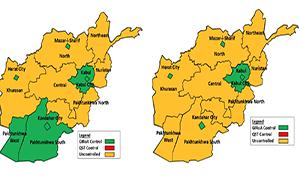Post-Negotiated Settlement Afghan Stability Dynamics

Post-Negotiated Settlement Afghan Stability Dynamics
Contributors: TRADOC G27 Models and Simulations Branch
Executive Summary
This paper provides the TRADOC G27 Models and Simulations Branch initial assessment for Phases I and II of the Strategic Multilayer Assessment (SMA) CENTCOM Afghanistan project. Phase I specifically assessed the impact of three different hypothetical Afghan government constructs: Centralized, Enhanced Local Governance and Decentralized (regional). Phase II focused on the potential outcomes of a negotiated settlement including: truce, power-sharing Afghan government, and reconciliation.
TRADOC G27 used the Athena Simulation to model the discrete futures listed above in order to assess the political and social outcomes of each future by measuring control, influence, support, security and the relationship between the population and GIRoA.2 This analysis was descriptive rather than prescriptive. Follow on efforts will use the results from the 19 November 2018 United States Institute for Peace workshop in order to further refine these potential futures.
Overall Insights
1. A decentralized (regional centric) form of government improved GIRoA control in some areas but opens these areas to regional leader and Quetta Shura Taliban (QST) control if the regional leaders withdraw their support from GIRoA.
2. While much of Afghanistan’s territory is not controlled by GIRoA the QST can only control large amounts of territory under very specific conditions.
3. A truce may be a necessary step towards any negotiated settlement between GIRoA and QST but by itself a truce does not result in any increased GIRoA control.
4. Irrespective of how the study scenario reintegrated QST fighters into the ANSF (both in number and ANSF component), it did not substantially impact GIRoA control or popular support over simply demobilizing them.
5. QST fighter demobilization resulted in by far the greatest improvement of GIRoA control and increase in GIRoA popular support of all the variables we assessed in both Phases I and II.
Comments